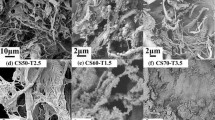Abstract
Aerogels of cellulose exhibit remarkable mechanical properties as a function of density. Modifying the pore volume in classical cellulose aerogels using sacrificial template methods provide scaffold like microstructure. In the present study, we have developed aerogels of cellulose scaffolds having almost same density values but differ in microstructure and analysed the influence on the mechanical properties of bulk materials. This study can give an insight into the materials design for advanced engineering materials. Employing four surfactants having difference in hydrophilic-lipophilic balance (HLB), namely polyoxyethylene tert-octylphenyl ether (PT), polyoxyethylene (20) oleyl ether (PO), polyoxyethylene (40) nonylphenyl ether (PN) and polyoxyethylene (100) stearyl ether (PS), the cellulose scaffolds with hierarchical porous structures were developed. The mechanical properties of cellulose scaffolds were compared with classical pure cellulose aerogels. The results indicate that the solid fraction of cellulose nanofibers per unit volume of cell walls of scaffolds plays an important role in determining the elastic properties and strength. As the nanofibrils support the cell walls of scaffolds, Young’s modulus can be improved if the concentration of cellulose nanofibers is high at the cell walls or cell wall thickness is larger. The scaffold materials of this kind could be used as supporting materials with desired properties for filter, catalysis and biomedicine.

Highlights
-
The aerogels of cellulose scaffolds with hierarchical porous structures were developed.
-
The hierarchical porous structures were designed by using four different surfactants.
-
The entrapped oil droplets in the cellulose matrix act as a structural template.
-
The solid fraction per unit volume of cell walls of scaffolds influences the mechanical property.
-
The structural design of pore channels play major role in defining the elastic property.








Similar content being viewed by others
References
Wang S, Lu A, Zhang L (2016) Recent advances in regenerated cellulose materials. Prog Polym Sci 53:169–206
Ratke L (2011) Monoliths and fibrous cellulose aerogels. In: Aegerter MA, Leventis N, Koebel MM (eds) Aerogels Handbook. Advances in Sol-Gel Derived Materials and Technologies. Springer, New York, p 173
Budtova T, Navard P (2016) Cellulose in NaOH-water based solvents: a review. Cellulose 23:5–55
Cai J, Kimura S, Wada M, Kuga S, Zhang L (2008) Cellulose aerogels from aqueous alkali hydroxide–urea solution. ChemSusChem 1:149–154
Wan C, Lu Y, Jiao Y, Cao J, Sun Q, Li J (2015) Cellulose aerogels from cellulose–NaOH/PEG solution and comparison with different cellulose contents. Mater Sci Technol 31(9):1096–1102
Rege A, Schestakow M, Karadagli I, Ratke L, Itskov M (2016) Micro-mechanical modelling of cellulose aerogels from molten salt hydrates. Soft Matter 12:7079–7088
Schestakow M, Karadagli I, Ratke L (2016) Cellulose aerogels prepared from an aqueous zinc chloride salthydrate melt. Carbohydr Polym 137:642–649
Hoepfner S, Ratke L, Milow B (2008) Synthesis and characterisation of nanofibrillar cellulose aerogels. Cellulose 15:121–129
Jin H, Nishiyama Y, Wada M, Kuga S (2004) Nanofibrillar cellulose aerogels. Colloids Surf A: Physicochem Eng Asp 240:63–67
Buchtová N, Budtova T (2016) Cellulose aero-, cryo- and xerogels: towards understanding of morphology control. Cellulose 23(4):2585–2595
Pääkkö M, Vapaavuori J, Silvennoinen R, Kosonen H, Ankerfors M, Lindström T, Berglund LA, Ikkala O (2008) Long and entangled native cellulose I nanofibers allow flexible aerogels and hierarchically porous templates for functionalities. Soft Matter 4:2492–2499
Li VC-F, Dunn CK, Zhang Z, Deng Y, Qi HJ (2017) Direct Ink Write (DIW) 3D printed cellulose nanocrystal aerogel structures. Sci Rep 7(1):8018
Pircher N, Fischhuber D, Carbajal L, Strau C, Nedelec J-M, Kasper C, Rosenau T, Liebner F (2015) Preparation and reinforcement of dual-porous biocompatible cellulose scaffolds for tissue engineering. Macromol Mater Eng 300:911–924
Ganesan K, Dennstedt A, Barowski A, Ratke L (2016) Design of aerogels, cryogels and xerogels of cellulose with hierarchical porous structures. Mater Des 92:345–355
Deng M, Zhou Q, Du A, van Kasteren J, Wang Y (2009) Preparation of nanoporous cellulose foams from cellulose-ionic liquid solutions. Mater Lett 63(21):1851–1854
Svagan AJ, Jensen P, Dvinskikh SV, Furó I, Berglund LA (2010) Towards tailored hierarchical structures in cellulose nanocomposite biofoams prepared by freezing/freeze-drying. J Mater Chem 20:6646–6654
Gibson LJ, Ashby MF (1997) Cellular solids: structure and properties. Second edn. Cambridge University Press, United Kingdom
Author information
Authors and Affiliations
Corresponding author
Ethics declarations
Conflict of interest
The authors declare that they have no conflict of interest.
Electronic supplementary material
Rights and permissions
About this article
Cite this article
Ganesan, K., Barowski, A., Ratke, L. et al. Influence of hierarchical porous structures on the mechanical properties of cellulose aerogels. J Sol-Gel Sci Technol 89, 156–165 (2019). https://doi.org/10.1007/s10971-018-4828-2
Received:
Accepted:
Published:
Issue Date:
DOI: https://doi.org/10.1007/s10971-018-4828-2




